Convenience meets expertise. Here's why Medicspot is your perfect healthcare partner.
Asthma is a long-term disease of the lungs. It causes your airways to get inflamed and narrow, which makes it hard to breathe. Severe asthma can cause trouble talking or being active. You might hear your doctor call it a chronic respiratory disease. Some people refer to asthma as “bronchial asthma.
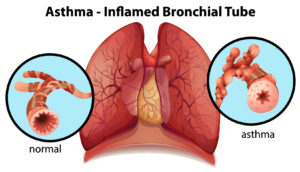
Asthma is marked by inflammation of the bronchial tubes, with extra sticky secretions inside the tubes. People with asthma have symptoms when the airways tighten, inflame, or fill with mucus.
The current data surrounding how asthma develops in a person finds that genetics and environmental influences are the most significant contributors. Additional factors that can determine whether a person develops asthma include:When you have an asthma attack, your airways narrow and it gets hard to breathe. This can result from spasms of the muscles around the airways, inflammation and swelling of the mucosal membrane that lines them, or high amounts of mucus inside them. You might have shortness of breath, wheeze or cough as your body tries to get rid of mucus.
Some known triggers of asthma attacks include:
. Allergies
. Food and food additives
. Exercise
. Heartburn
. Smoking
. Sinusitis
. Medications
. Weather
. Smoke
As a condition that targets the respiratory system, asthma features symptoms that can make life more difficult on a constant or episodic basis. The primary symptom for those with the condition is an asthma attack, a sudden worsening of asthma symptoms that leaves a person far less capable or even immobilized until the attack passes. Such symptoms that are exacerbated include:
. Chest tightness
. Coughing
. Difficulty communicating
. Increased heart rate
. Shortness of breath
. Wheezing
Symptoms may include headaches, shortness of breath, chest pain, and nosebleeds. It may feel asymptomatic or present with subtle signs at first, but advanced cases include persistent headaches, difficulty breathing, chest discomfort, or nosebleeds.
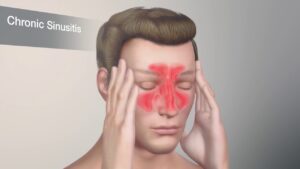
Chronic allergies are a widespread condition that affects millions of people worldwide. An allergy occurs when the immune system overreacts to a foreign substance that is typically harmless to most people. Some of the most common chronic allergies include hay fever (allergic rhinitis), eczema, drug allergies, and food allergies.
The symptoms of chronic allergies are often persistent and can be difficult to manage. Some people may experience severe or mild allergy symptoms, including:
. Sinus Congestion – Blockage or stuffiness of the nasal passages.
. Coughing – Allergic coughing is a reaction to allergens such as pollen, dust mites, or pet dander.
Persistent Sneezing – A reflex action that occurs when the nasal passages are irritated by allergens.
. Itching – A common symptom of allergies that can affect the skin, eyes, nose, and throat.
. Facial Congestion – Feeling of pressure, fullness, or tightness in the face, usually around the sinuses or nasal passages.
Urticaria – Also known as hives, this is a skin condition characterized by the sudden appearance of itchy, red, or white welts or bumps on the skin.
Chronic allergies can also lead to life-threatening symptoms, such as asthma attacks and anaphylaxis.
The treatment for chronic allergies and allergy medications depends on the severity of symptoms and your medical history. Some commonly prescribed medications for chronic and seasonal allergies include:
. Singulair – A leukotriene receptor antagonist that helps to reduce inflammation and swelling in the airways, making it easier to breathe.
. Azelastine – An antihistamine that helps to reduce the symptoms of allergies, such as sneezing, itching, and runny nose.
. Prednisone pack – A corticosteroid that is prescribed for severe allergy symptoms, such as difficulty breathing or swelling of the face and throat.
. Cetirizine – An antihistamine that can be used to relieve allergy symptoms such as sneezing, runny nose, and itchy or watery eyes.
. Flonase – A corticosteroid nasal spray that helps to reduce inflammation in the nasal passages.
It is important to consult with a healthcare provider to diagnose your allergies and determine the best way to treat your allergies, as some medications may have negative interactions with others or have potential side effects due to undetected drug allergies.
Type 2 diabetes is a lifelong disease that keeps your body from using insulin the way it should.
People who are middle-aged or older are most likely to get this kind of diabetes. It used to be called adult-onset diabetes or diabetes mellitus. But type 2 diabetes also affects kids and teens, mainly because of childhood obesity.
Type 2 is the most common form of diabetes. About 1 in 10 people in the U.S. have type 2. Nearly 1 in 3 have prediabetes, meaning their blood sugar (or blood glucose) is high but not high enough to be diabetes yet.
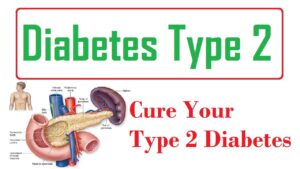
Type II diabetes is the most common form of diabetes. This condition affects how the body uses sugar. Sugar is essential for the normal function of cells. Normally, the body releases insulin to move sugar into the cells to be used as energy.
In type II diabetes, the body does not produce enough insulin or the cells do not respond to the insulin leading to less intake of sugar into the cells. This leads to a build-up of sugar in the blood. Left unchecked, high blood sugar can lead to the development of serious problems like kidney and heart disease, as well as vision loss. Unfortunately, 20% of people with diabetes may never know they have it.
Type II diabetes is caused by insulin resistance. The cells in the body respond less and less to insulin which results in less sugar being taken into the cells. In turn, the blood sugar rises. In addition, the pancreas stops producing an adequate amount of insulin to keep the blood sugars within a normal range.
The symptoms of type 2 diabetes can be so mild that you don't notice them. About 9 million people have it and don't know it. Symptoms include:
Being very thirsty
Peeing a lot
Blurry vision
Tingling or numbness in your hands or feet
Fatigue/feeling worn out
Wounds that don't heal
Yeast infections that keep coming back
Feeling hungry
Weight loss without trying
Getting infections
Heartburn is an irritation of your esophagus, the tube that connects your throat and stomach. This leads to a burning discomfort in your upper belly or chest.
It's caused by acid reflux, which is when your lower esophageal sphincter (LES) muscle doesn't close properly, letting stomach acids back up into your esophagus.
You've probably had heartburn, and it’s usually not serious.
If you have it often, you may have something else called gastroesophageal reflux disease, or GERD. If you don't get it treated, GERD can sometimes cause problems, like:
Inflammation and ulcers in the esophagus
Hoarseness
Some types of lung disease
Barrett's esophagus (when your esophagus is damaged by acid reflux)
Heartburn Symptoms
Heartburn feels like a burning sensation in the middle of your chest and throat. You may also have:
Burning pain in your chest after you eat or at night
Pain that worsens when you bend over or lie down
A hot, acidic, bitter, or salty taste in the back of your throat
A hard time swallowing
A feeling of food "stuck" in the middle of your chest or throat
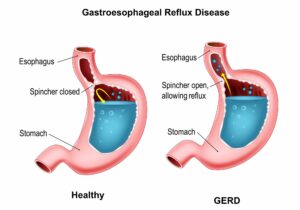
Heartburn symptoms can start when the lower esophageal sphincter (LES) valve at the bottom of your esophagus doesn't close correctly.
It should stay closed to keep food and stomach acids in your stomach. When you're eating, your LES opens so food can go into your stomach. Then it closes again. If it doesn't close, even just a little, or if it opens when it shouldn't, stomach acids can go back into your esophagus, causing heartburn pain.
We don't know what causes the LES valve to weaken, but it could be caused by eating big meals too often, if you're overweight, or you have a hiatal hernia (a hernia in your upper stomach that pushes through your diaphragm).
Heartburn risk factors
Certain foods can relax your LES or increase stomach acid, including:
. Tomatoes
. Citrus fruits
. Garlic and onions
. Chocolate
. Coffee or caffeinated products
. Alcohol
. Peppermint
. Foods high in fats and oils
Heartburn feels like a burning sensation in the middle of your chest and throat. You may also have:
Burning pain in your chest after you eat or at night
Pain that worsens when you bend over or lie down
A hot, acidic, bitter, or salty taste in the back of your throat
A hard time swallowing
A feeling of food "stuck" in the middle of your chest or throat
Gout symptoms involve sudden and severe joint pain, swelling, redness, and tenderness, commonly affecting the big toe. It may feel intensely painful, with joints becoming hot and sensitive.
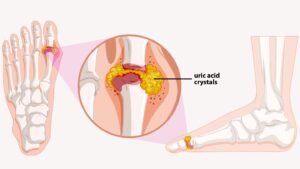
Gout is a type of inflammatory arthritis that causes pain and swelling in your joints, usually as flares that last for a week or two, and then resolve. Gout flares often begin in your big toe or a lower limb. Gout happens when high levels of urate build up in your body over a long period of time, which can then form needle-shaped crystals in and around the joint. This leads to inflammation and arthritis of the joint. When the body makes too much urate, or removes too little, urate levels build up in the body. However, many people with high levels of serum urate will not develop gout.
Gout causes and symptoms are primarily the result of an excess of uric acid in the bloodstream, a condition known as hyperuricemia. This excessive uric acid can lead to the formation of urate crystals, which can accumulate in the joints, typically in the big toe but also in other joints. Also decided by lifestyle factors and habits, what causes gout can also include:
. A diet rich in meat and seafood
. Drinking alcohol, especially beer
. Drinking sweetened drinks
. Obesity
. Certain medications such as thiazide diuretics and aspirin
Genetics
Gout symptoms are generally sudden and severe in the affected joint, often in the big toe, though it can occur in other joints. Common gout symptoms can include:
. Intense and sudden joint pain
. Swelling and inflammation
. Limited mobility from the affected joint
Blood pumping through the circulatory system is under pressure, much like the water in the pipes of a house. And just as too much water pressure can damage pipes and faucets, elevated blood pressure can spell trouble. Hypertension occurs when the force exerted against artery walls is abnormally high.
Over time, elevated pressure can cause a wide range of problems. Small bulges, called aneurysms, may form in blood vessels. The heart can become enlarged, increasing the danger of heart attack and heart failure. Damage to blood vessels in the kidneys can cause them to fail. Because tiny blood vessels in the eyes are especially vulnerable to damage, hypertension can lead to vision problems and even blindness.
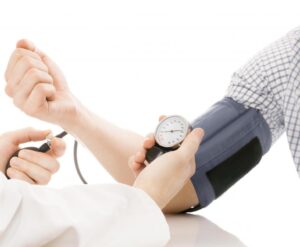
High blood pressure -- in men and women -- is a big problem. One in every three adult Americans -- about 65 million people -- have high blood pressure, also known as hypertension. Many more are at risk of developing it. Over half of all Americans age 60 and older have it and over a lifetime, the risk of developing high blood pressure is 90%.
Typically, blood pressure increases with age. Risk of high blood pressure begins to climb when people hit age 45, although it can occur in younger people. Blacks tend to develop it younger and have more severe hypertension. Obesity or a family history of high blood pressure also increases risk.
High blood pressure is especially dangerous because people can have it for years without knowing. In fact, 1 in 3 Americans with the condition doesn’t know it.
Despite these gloomy statistics, high blood pressure is not inevitable. There is plenty you can do to prevent, delay, and treat the condition.
Blood pressure is the measure of the force of blood pushing against blood vessel walls. The heart pumps blood into blood vessels, which carry the blood throughout the body.
High blood pressure, also called hypertension, means your heart is working harder to pump blood out to the body. It's a dangerous condition and contributes to hardening of the arteries, or atherosclerosis, stroke, kidney disease, and heart failure.
High blood pressure, or hypertension, affects nearly half of adults in the U.S. Because it usually doesn’t make you feel sick, many people are surprised to hear that they have it.
However, high blood pressure can have a big impact on your health, so it is important to understand what it is, what causes it, and how you can lower it.
High blood pressure (hypertension) is often called the “silent killer” because it typically has no symptoms. However, if left uncontrolled, it can lead to serious health problems such as heart disease (heart attack), stroke, and kidney disease over time.
Although symptoms can be difficult to detect and identify, Some symptoms can include:
. Headaches - Particularly in the morning, which may be accompanied by blurred vision, dizziness, or nausea.
. Shortness of breath - Feeling breathless during physical activity or even at rest.
. Chest pain - Discomfort or tightness in the chest.
. Fatigue - Feeling tired or weak regardless of your physical or mental strain that day.
High cholesterol often lacks noticeable symptoms, but it may manifest as chest pain, yellowish skin growths (xanthomas), or white rings around the cornea (arcus senilis). It most often is asymptomatic until later stages.
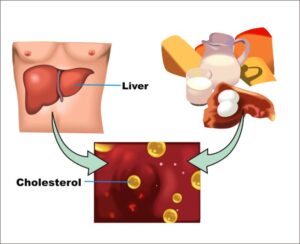
Cholesterol is a fatty substance that naturally occurs in human blood. It is formed in the liver or comes from the foods you eat. Cholesterol performs important functions in your body. It aids in tissue and hormone formation. It protects your nerves. It helps with digestion. In fact, cholesterol helps form the structure of every cell in your body.
High cholesterol, specifically elevated levels of low-density lipoprotein (LDL) cholesterol, is often caused by a combination of genetic and lifestyle factors. Genetic factors can predispose some individuals to high cholesterol levels. However, lifestyle factors can include:
. Diets high in saturated and trans fats
. Excessive intake of dietary cholesterol
. Excessive alcohol consumption
. Lack of physical activity
. Smoking
A high level of cholesterol in the blood doesn't have obvious symptoms, but it can increase your risk for conditions that do have symptoms, including angina (chest pain caused by heart disease), high blood pressure, stroke, and other circulatory ailments. Also:
Soft, yellowish growths or lesions on the skin called xanthomas may suggest elevated levels of cholesterol.
Many people who are obese or have diabetes also have high cholesterol.
In men, impotence may be caused by arteries affected by too much blood cholesterol.
High cholesterol can be treated through a combination of lifestyle changes and medication.
In addition to lifestyle changes, CallonDoc can prescribe cholesterol medication to help lower your cholesterol levels. The most commonly used cholesterol medications are statins, bile acid sequestrants, and cholesterol absorption inhibitors. The choice of medication will depend on your individual health needs and risk factors.
The silent killer, hypertension progresses slowly and is most often asymptomatic during the early stages. When symptoms are felt, they generally include headaches, shortness of breath, chest pain, or nosebleeds.
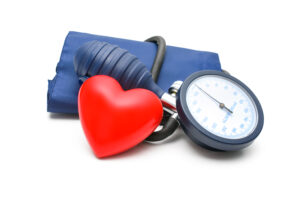
Hypertension, also known as high blood pressure, is a chronic medical condition that affects over a billion people worldwide. It is characterized by elevated pressure within the arteries, putting strain on the heart and increasing the risk of cardiovascular diseases. Hypertension typically develops over time and is often referred to as a "silent killer" due to its tendency to present few or no symptoms.
Various risk factors contribute to the development of hypertension, including genetics, age, lifestyle choices (including diet), and certain underlying medical conditions such as obesity. Hypertension can lead to severe health complications, such as heart attacks, strokes, kidney disease, vision impairment, and other medical problems. Fortunately, there are various treatment options for high blood pressure.
If lifestyle changes alone are insufficient, healthcare professionals may prescribe hypertension medications to manage blood pressure effectively. These medications work by relaxing blood vessels or reducing the volume of blood the heart pumps, resulting in decreased pressure of blood pushing against artery walls.
Blood pressure is measured in millimeters of mercury (mm Hg) and is expressed as two numbers: systolic pressure (the top number) and diastolic pressure (the bottom number).
Normal Blood Pressure: a reading of less than 130/80
Hypertension can arise from various underlying factors, leading to two main categories: primary and secondary hypertension. Primary hypertension, the most prevalent form, develops gradually and is influenced by genetic, environmental, and lifestyle factors. Collectively, each contributes to the development of the condition over time. These factors include:
-Genetic predisposition and family history.
-Unhealthy diet, particularly high sodium intake.
-Excess body weight and obesity.
-Sedentary lifestyle and lack of exercise.
-Chronic stress and poor stress management.
-Age-related changes in blood vessels.
-Unlike primary hypertension, secondary hypertension has a specific identifiable cause that can be treated or managed to help control blood pressure. These causes include the following:
-Kidney disease, including chronic kidney disease and renal artery stenosis.
-Hormonal imbalances like hyperthyroidism, Cushing's syndrome, or primary aldosteronism.
-Sleep apnea and breathing disruptions during sleep.
-Certain medications, such as NSAIDs, decongestants, and hormonal birth control.
-Pregnancy-related hypertension (gestational hypertension or preeclampsia).
-Adrenal gland disorders affect hormone production.
-Thyroid disorders influencing blood pressure regulation.
-Chronic alcohol consumption contributes to elevated blood pressure.
In many cases, hypertension does not present any noticeable symptoms. However, some individuals with high blood pressure may experience one or more of the following symptoms:
-Nosebleeds
-Chest pain (angina)
-Fatigue or confusion
-Vision problems (e.g., blurred vision)
-Irregular heartbeat or palpitations
-Headaches (particularly in the morning)
-Shortness of breath (especially during physical activity)
Insomnia is a sleep disorder in which you have trouble falling and/or staying asleep.
The condition can be short-term (acute) or can last a long time (chronic). It may also come and go.
Acute insomnia lasts from 1 night to a few weeks. Insomnia is chronic when it happens at least 3 nights a week for 3 months or more.
Insomnia is a very common sleep disorder characterized by difficulty falling asleep or remaining asleep. It is not considered a mental illness, but it can relate to your mental health and wellbeing. Many people have episodes of insomnia that last a few days. In any given year, as much as half of the population will experience disruptions to their sleep patterns due to this condition.
Insomnia, especially long-term chronic insomnia, is believed to be caused by stress, anxiety, depression, or other medical conditions. Individuals with current conditions that are the most common causes of insomnia are at an increased risk of developing serious medical conditions, such as coronary heart disease, high blood pressure, and diabetes.
Many people with chronic insomnia report feeling exhausted on a regular basis and experiencing an overall reduced quality of life. In some cases, the best treatment for insomnia is to take prescribed sleep medicine—not “sleeping pills”—under the direction of a doctor. Prescription medications commonly used in treating symptoms of insomnia include hydroxyzine (Vistaril) and trazodone (Desyrel).
Stress related to big life events, like a job loss or change, the death of a loved one, divorce, or moving
Things around you like noise, light, or temperature
Changes to your sleep schedule like jet lag, a new shift at work, or bad habits you picked up when you had other sleep problems Your genes. Research has found that a tendency for insomnia may run in families.
Symptoms of insomnia include:
. Sleepiness during the day
. Fati.ue
. Grumpiness
. Problems with concentration or memory
A migraine is a type of headache with symptoms that can differ from those of non-migraine headaches. These may include unusual symptoms that can be scary, like tingling sensations, flashing lights, weird sounds, and blurred or lost vision. In some cases, you might get nauseated and throw up, or become sensitive to light and hole up in a dark room for days. If you know your symptoms, you may be able to predict when a migraine is on the way.
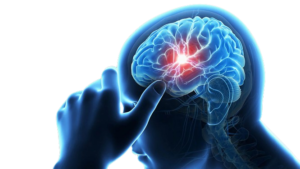
Migraine is a brain and nervous system disorder whose symptoms almost always include intense headaches. You get these headaches repeatedly, in episodes that can last anywhere from 4 to 72 hours. Along with head pain, they include other symptoms like nausea and sensitivity to light.
Migraines are believed to be caused by several external and internal factors, with many being innate to those who get them. Such factors for migraine development can include:
Genetic predisposition
Hormonal changes, especially in women
Certain foods and beverages, such as aged cheeses, alcohol, and caffeine
Environmental factors, like changes in weather or strong odors
Stress and emotional factors
Sleep disturbances
Physical factors, such as intense physical exertion
Medications and hormonal treatments
Typical symptoms of migraine include the following:
Throbbing or pulsatile headache, with moderate to severe pain that intensifies with movement or physical activity
Unilateral and localized pain in the frontotemporal and ocular area, but the pain may be felt anywhere around the head or neck
Pain builds up over a period of 1–2 hours, progressing posteriorly and becoming diffuse
Headache lasts 4–72 hours
Nausea (80%) and vomiting (50%), including anorexia and food intolerance, and light-headedness
Sensitivity to light and sound
Flu feels abrupt with fever, chills, muscle pain, and fatigue. Symptoms include cough, sore throat, and headache. Noticeable weakness, body aches, and respiratory distress may accompany
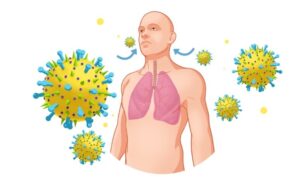
Influenza, commonly referred to as the flu, is a highly contagious respiratory illness caused by influenza A or B viruses. It strikes mainly during the winter season, causing a range of symptoms from mild to severe. Schoolchildren are particularly susceptible due to their close contact in crowded environments, such as classrooms.
To reduce the spread of influenza, annual flu vaccination campaigns are critical. Vaccination not only helps reduce the severity of symptoms during flu season but also lowers the risk of infection and subsequent transmission. Additionally, promoting good hygiene practices, such as frequent handwashing and covering coughs and sneezes, can aid flu prevention.
Most commonly, symptoms start to show about 1 to 3 days after being exposed to the influenza virus. Fortunately, medications like antiviral drugs can help treat flu symptoms and shorten the duration of illness if taken within the first 48 hours of symptom onset. These medications work by targeting the virus's replication, reducing its impact on the body.
The flu, or influenza, is caused by influenza viruses that infect the respiratory system. These viruses belong to different types and strains, with the most common ones being influenza A and B viruses. The flu is highly contagious and spreads through respiratory droplets when an infected person coughs, sneezes, or talks. Additionally, the virus can also be contracted by touching surfaces or objects contaminated with flu virus and then touching the mouth, nose, or eyes. Over time, any flu virus can mutate and change over time, leading to new strains that may cause reinfection and different symptoms.
Fever or feeling feverish (not everyone will experience this)
. Cough
. Runny or stuffy nose
. Sore throat
. Muscle pains or body aches
. Headache
. Fatigue and weakness
. Chills
. Sweating
. Nausea or vomiting (more common in children)
. Diarrhea (more common in children)
Doctors often treat the flu with a combination of supportive care and antiviral medications. Supportive care involves rest, staying hydrated, and managing symptoms with over-the-counter pain relievers. Antiviral medications like oseltamivir (Tamiflu) or zanamivir (Relenza) can be prescribed, especially for high-risk individuals or those with severe symptoms. These medications can shorten the duration of the illness and reduce the severity of symptoms by inhibiting the virus's ability to replicate. Treatment is most effective when started within the first 48 hours of symptom onset.
Smoking cessation treatment aids by addressing nicotine addiction, reducing withdrawal symptoms, and providing behavioral support. Medications enhance the chances of successfully quitting and promote a healthier lifestyle.
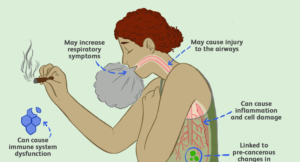
Tobacco use, primarily cigarette smoking, is the leading cause of preventable disease and death in the United States. Smoking cessation lowers the risk of cancer and other serious health problems.
Adding {{itemName}} to cart
Added {{itemName}} to cart